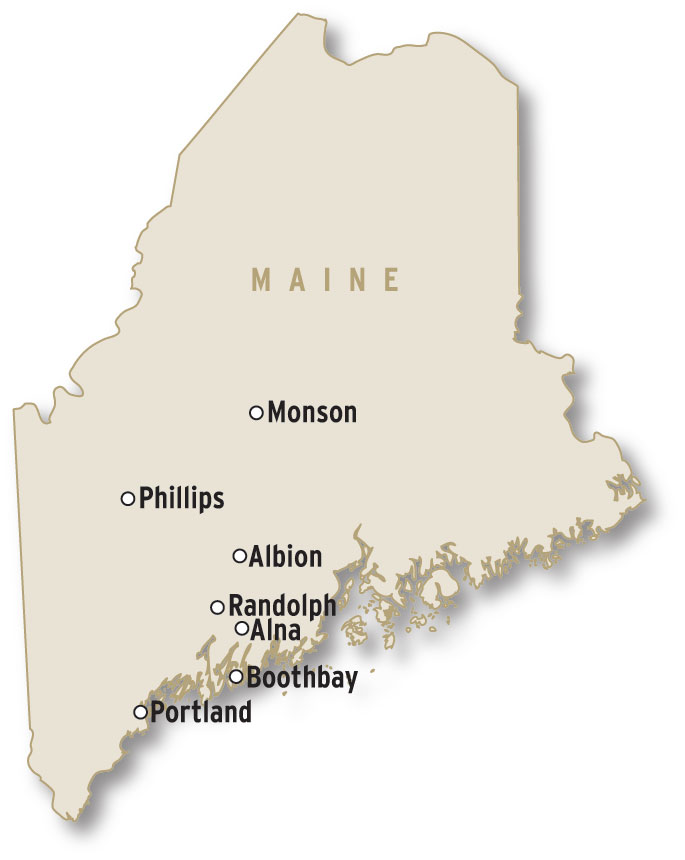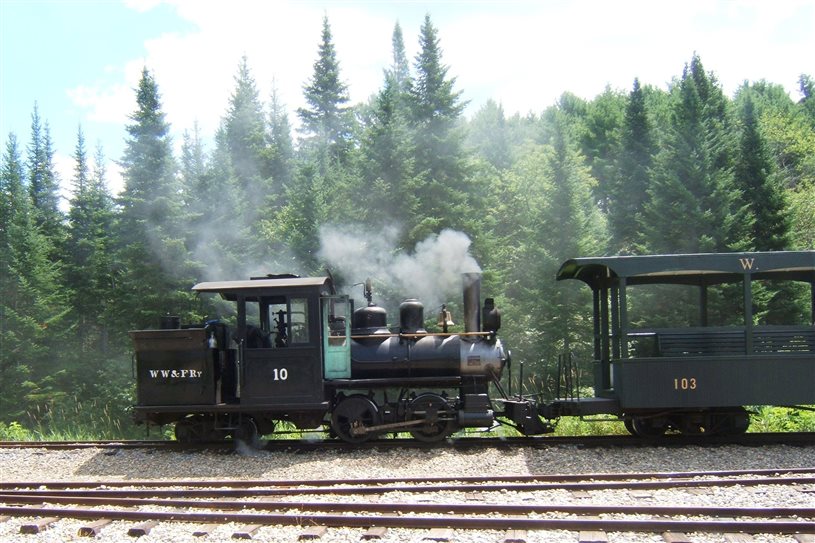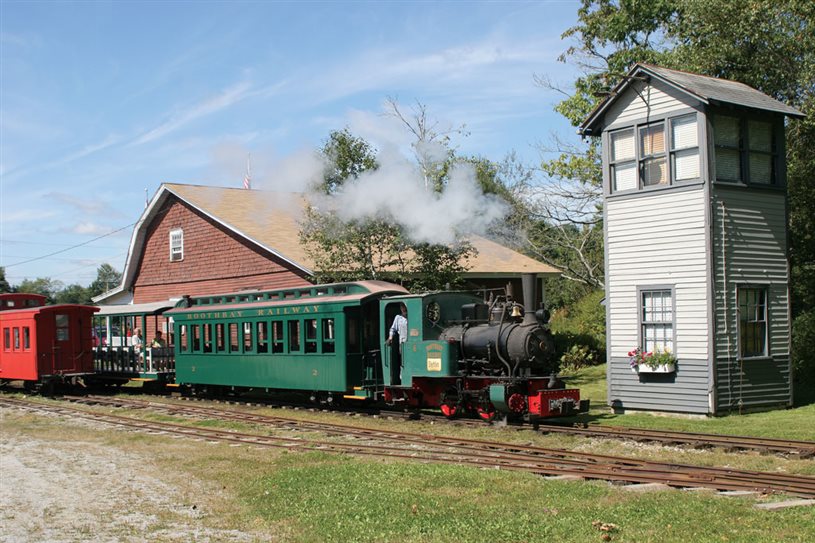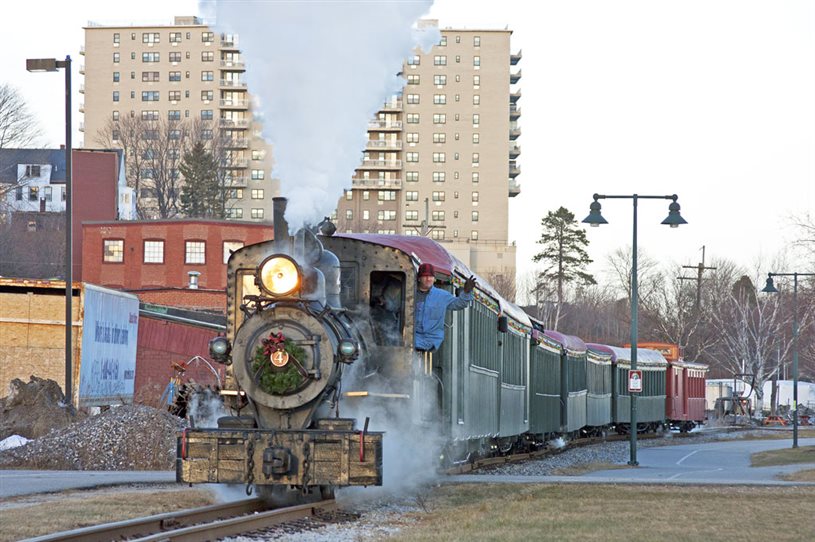With the advent of the automobile and the Great Depression, the Maine two-footers were gone by World War II. However, Ellis D. Atwood saved equipment and in the late 1940s moved it to Massachusetts, where it ran until 1992. Much of that equipment became the basis for today’s operations.
An hour north lies one of the most impressive railroad restorations in America: The Wiscasset, Waterville & Farmington Railway Museum in Alna. This dedicated group of volunteers has rebuilt more than 2 miles of track, a four-stall shop, a freight house, a water tank, and two stations, as well as rebuilt or built-from-scratch 2-foot-gauge equipment. The group operates 0-4-4T No. 10, which started its life on a 30-inch-gauge plantation railroad in Louisiana, and and is restoring WW&F No. 9, the oldest Maine narrow gauge locomotive in existence.. The engine is expected to be completed in 2015. The annual picnic, held each August, is perhaps the best time of year to go as the museum runs extra trains. See www.wwfry.org.
Not far from Alna is the Boothbay Railway Village, the oldest 2-foot-gauge museum in the state. Boothbay’s loop of track features three German-built 0-4-0Ts hauling passengers on excursions. One of the best spots for photography is the covered bridge, and on the far end of the loop there is a small station and a rebuilt town that make a great photo prop. See www.railwayvillage.org.
Further inland is the Sandy River & Rangeley Lakes Railroad in Phillips. While the original railroad once stretched across the mountains of western Maine, today’s version is just a half-mile long. The operation has rebuilt six original structures as well as built a new eight-stall roundhouse. The jewel of the fleet is former Monson Railroad 0-4-4T No. 3, which is on a long-term lease from the Portland museum. See www.srrl-rr.org.
You can find locations across the state with more narrow gauge history. In Monson, check out an old restored freight house. In Albion, the local historical society rebuilt the former WW&F station and a short stretch of track with a flanger. Near Randolph, volunteers cleared parts of the former Kennebec Central right-of-way as a hiking trail.




















My wife and I rode MNG and WWF 3 years ago on our honeymoon. Drove by Boothbay, but we were on our way to the nearby gardens (also went to Seashore and Lowell on the trip). I hope to get back someday . . . after all, there's plenty more WWF to ride already!
Nothing wrong with those German 0-4-0's. If you're a student of the First World War they're as close as you'll ever get to one of the "Feldbahn" narrow gauge locomotives that supplied the troops in the trenches.
The Cripple Creek and Victor Railroad in Cripple Creek CO has one of those German 0-4-0's. I've ridden behind it, it's cool!
Well. if 24" gauge locomotives are in short supply, and they are, as the saying goes "You do what you gotta do!" That being the case a 60 cm German locomotive fills the bill quite nicely.
Now that's not so bad, is it?
The Maine Narrow Gauge line is moving to Gray, not to Gary. I rode this short line this summer and the combination of narrow gauge and seacoast makes for a great excursion.
Appropriate for Europe, but in Maine??? What next? A 2'-0" gauge Wakayama Railway "Tama Densha" from Japan?
I should also add that Boothbay is well worth the stop, too. The displays and ride are family oriented and authentic. A steam locomotive is universal so there is no reason to ignore the German name and European look….all is part of the Maine Two Foot experience and Boothbay is minutes off Route 1 and a must ride experience, too.
I was always curious about the Maine Two Foot Empire but it wasn't until about 2003 when my son moved his family to Portland that I fell totally in love with it. The Atwood ride at the Portland waterfront is on former standard gauge right of way and track with the rails set at 24 inches…but it is so easy to get to you cannot ignore. Soon it will be moving to Gary, ME onto its own property about 25 miles north and west. But it should whet your appetite enough to have to drive up to Elna to take in the most extensive exhibit, preservation, and ride of narrow gauge railroading in the East…so much preserved and presented you'll have to stay and come back. The most unique and elusive is the Sandy River and Rangeley Lakes operation in Phillips and so, so worth the trip into the near wilderness and near perfect replication of the original setting and reason for narrow gauge. This is for purists more than the other two if only because the details presented by the guide are, well, details beyond what normal tourist riders and non rail and forestry fans care to hear. But, the tour of the round house, the ride down the hill to the site from the station and parking lot, is fantastic. Riding back in the rain, for me, was the greatest because when boarding for the return leg of the trip it was announced that there was room for two more people in the cab for the half mile or so trip. It was "me and whoever else" and I was the only one to take them up on the offer. (My personal pride is having a cab ride in 1970 on Ross Rowland's NKP 759 and this little Maine Two Footer some 35 years later; the big and the small of steam cab rides, but really both big rides.) I warn you, you don't know what you're missing if you don't stop at at least one Maine two footer. And I guarantee you can't stop at just one.
The "restored freight house" in Monson is actually a combination depot and freight house, and the depot at Monson Jct. in Abbot, where the Monson Railroad interchanged with the Bangor & Aroostook, is still standing.
The "restored freight house" in Monson is actually a combination depot and freight house, and the Monson Railroad's other depot, the Bangor & Aroostook
Would be nice if the Boothbay Railway would 'Americanize' their locomotives. Just some black paint would do wonders. The oval windows and arched cab entrance need to go. A couple of guys, a torch, and some Allen's Brandy would fix them in a heartbeat.